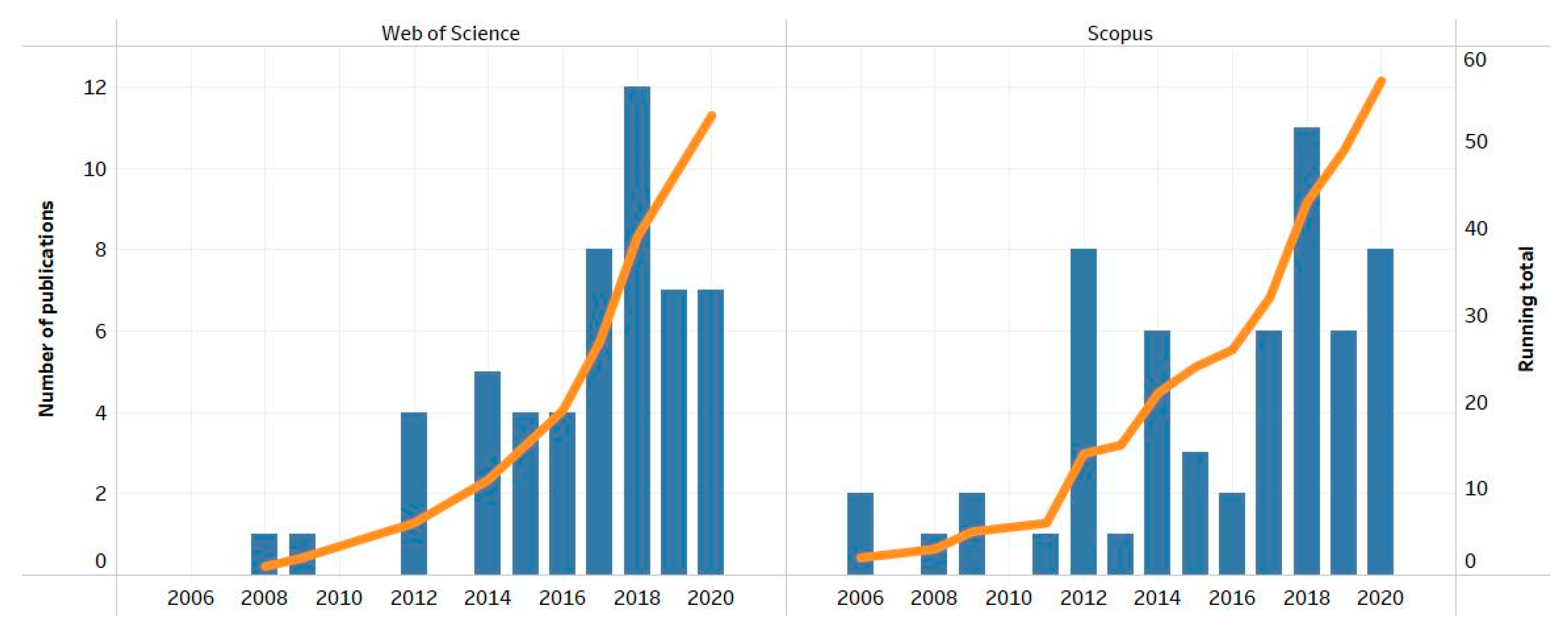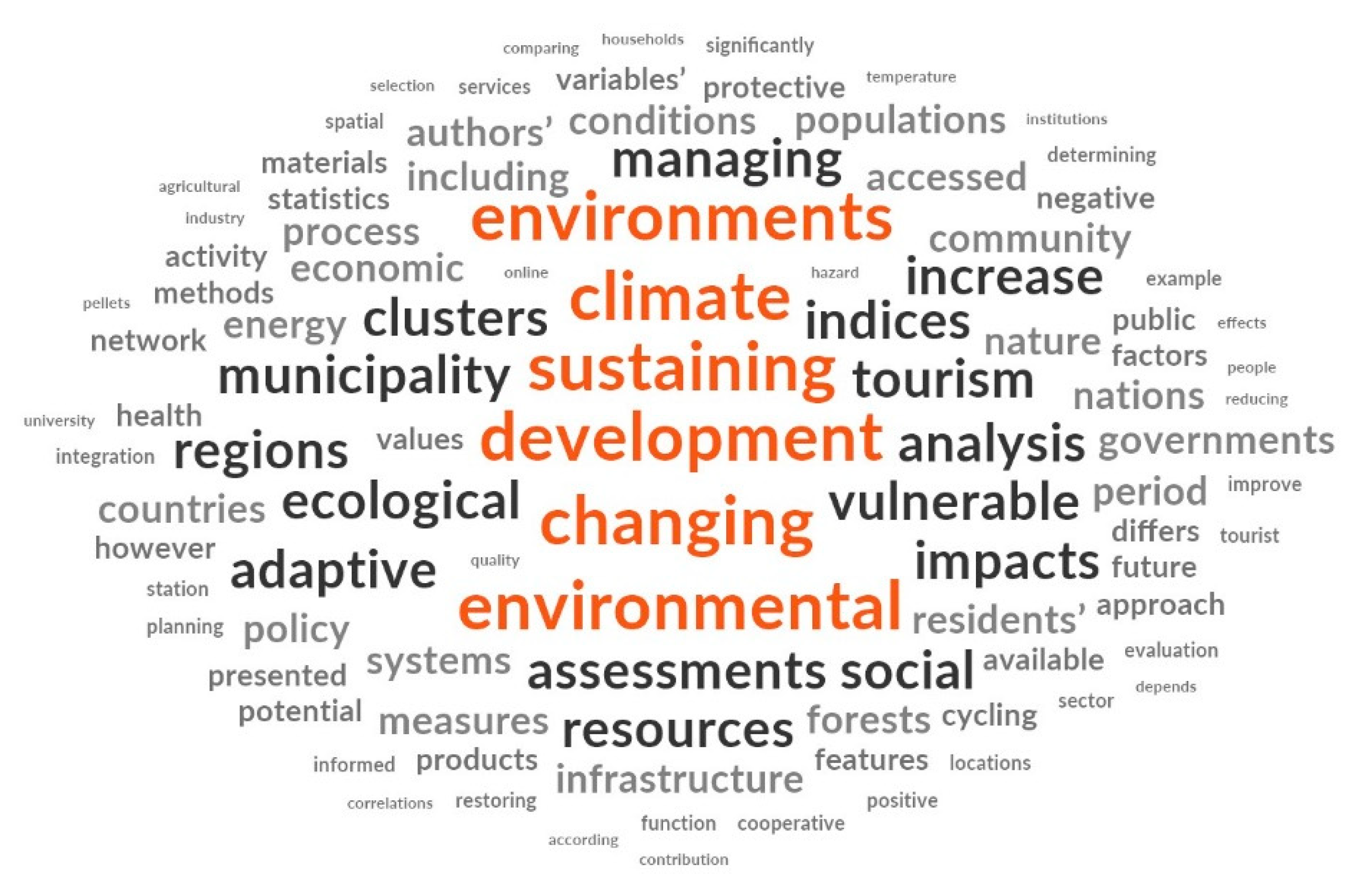Socio-Environmental Vulnerability Assessment for Sustainable Management
- How can the resilience of environmental and social systems to changing climate or hydrological threats be assessed? Multidimensional and multi-factorial issues require new approaches and analytical tools. Hierarchical methods, clustering, and ranks have been successfully tested by the authors whose work is included in this volume [26,27,28,29].
- What is the future of social–environmental systems? How will demographic change, particularly in an aging society, affect social and environmental resilience [33]? How should we supply ourselves with energy [34,35,36]? How should we shape our transport systems [37]? How can technical infrastructure and spatial management support the development of tourism in environmentally valuable areas [38]? Can we leverage our efforts by applying nature-based solutions [39,40]? How can open data and artificial intelligence support us [41,42]?
Acknowledgments
Conflicts of Interest
References
- Holling, C.S. Resilience and Stability of Ecological Systems. Annu. Rev. Ecol. Syst. 1973, 4, 1–23. [Google Scholar] [CrossRef] [Green Version]
- Pulver, S.; Ulibarri, N.; Sobocinski, K.L.; Alexander, S.M.; Johnson, M.L.; McCord, P.F.; Dell’angelo, J. Frontiers in socio-environmental research: Components, connections, scale, and context. Ecol. Soc. 2018, 23. [Google Scholar] [CrossRef] [Green Version]
- Turner, B.L.; Kasperson, R.E.; Matsone, P.A.; McCarthy, J.J.; Corell, R.W.; Christensene, L.; Eckley, N.; Kasperson, J.X.; Luers, A.; Martello, M.L.; et al. A framework for vulnerability analysis in sustainability science. Proc. Natl. Acad. Sci. USA 2003, 100, 8074–8079. [Google Scholar] [CrossRef] [PubMed] [Green Version]
- Turner, B.L.; Esler, K.J.; Bridgewater, P.; Tewksbury, J.; Sitas, J.N.; Abrahams, B.; Chapin, F.S.; Chowdhury, R.R.; Christie, P.; Diaz, S.; et al. Socio-Environmental Systems (SES) Research: What have we learned and how can we use this information in future research programs. Curr. Opin. Environ. Sustain. 2016, 19, 160–168. [Google Scholar] [CrossRef]
- Roggero, M.A.; Ziglio, L.; Miranda, M. Socio-environmental vulnerability, analysis of health situation and indicators: Implications for the quality of life in the city of Sao Paulo. Confin. Fr. Geogr. Fr. Geogr. 2018, 36, 17. [Google Scholar] [CrossRef]
- Kran, F.; Ferreira, F.P.M. Life quality in Palmas-To: An analysis through housing and urban environmental indicators. Ambient. Soc. 2006, 9, 123–141. [Google Scholar] [CrossRef] [Green Version]
- Londe, L.R.; Marchezini, V.; da Conceição, R.S.; Bortoletto, K.C.; Silva, A.E.P.; dos Santos, E.V.; Reani, R.T. Impacts of socio-environmental disasters on public health: Studies of scenarios in the Brazilian states of Santa Catarina in 2008 and Pernambuco in 2010. Rev. Bras. Estud. Popul. 2015, 32, 537–562. [Google Scholar] [CrossRef] [Green Version]
- Houghton, A.; Prudent, N.; Scott, J.E.; Wade, R.; Luber, G. Climate change-related vulnerabilities and local environmental public health tracking through GEMSS: A web-based visualization tool. Appl. Geogr. 2012, 33, 36–44. [Google Scholar] [CrossRef]
- de Mendonca, M.B.; da-Silva-Rosa, T.; Monteiro, T.G.; de Souza Matos, R. Improving Disaster Risk Reduction and Resilience Cultures Through Environmental Education: A Case Study in Rio de Janeiro State, Brazil. In Climate Change and Health; Springer: Cham, Switzerland, 2016; pp. 279–295. [Google Scholar]
- Silva, R.T. Integration of hydraulic infrastructure in metropolitan São Paulo. Prospects of change in a context of growing vulnerability. Geogr. Helv. 2011, 66, 92–99. [Google Scholar] [CrossRef] [Green Version]
- Zanetti, V.B.; Junior, W.C.S.; De Freitas, D.M. A climate change vulnerability index and case study in a Brazilian Coastal City. Sustainability 2016, 8, 811. [Google Scholar] [CrossRef] [Green Version]
- Goncalves, K.D.; Siqueira, A.S.P.; de Castro, H.A.; Hacon, S.D.S.; Gonçalves, K.S.; Siqueira, A.S.P.; de Castro, H.A.; Hacon, S.D.S. Indicator of socio-environmental vulnerability in the Western Amazon. The case of the city of Porto Velho, State of Rondonia, Brazil. Cienc. Saude Coletiva 2014, 19, 3809–3817. [Google Scholar] [CrossRef]
- Westin, F.F.; dos Santos, M.A.; Martins, I.D. Hydropower expansion and analysis of the use of strategic and integrated environmental assessment tools in Brazil. Renew. Sustain. Energy Rev. 2014, 37, 750–761. [Google Scholar] [CrossRef]
- Castillo-Oropeza, O.A.; Delgado-Hernández, E.; García-Morales, Á. Gentrification and disaster in La Condesa Zone. Bitacora Urbano Territ. 2018, 28, 35–43. [Google Scholar] [CrossRef] [Green Version]
- Szewrański, S.; Świąder, M.; Kazak, J.K.; Tokarczyk-Dorociak, K.; van Hoof, J. Socio-Environmental Vulnerability Mapping for Environmental and Flood Resilience Assessment: The Case of Ageing and Poverty in the City of Wrocław, Poland. Integr. Environ. Assess. Manag. 2018, 14, 592–597. [Google Scholar] [CrossRef] [PubMed] [Green Version]
- Barros, M.V.F.; Mendes, C.; de Castro, P.H.M. Social-environmental vulnerability to floods in urban areas of Londrina city-PR. Confin. Fr. Geogr. Fr. Geogr. 2015, 24, 21. [Google Scholar] [CrossRef]
- Castro, B.; Filho, W.L.; Caetano, F.J.P.; Azeiteiro, U.M. Climate Change and Integrated Coastal Management: Risk Perception and Vulnerability in the Luanda Municipality (Angola). In Climate Change Impacts and Adaptation Strategies for Coastal Communities; Springer: Cham, Switzerland, 2018; pp. 409–426. [Google Scholar]
- Claeys, C.; Giuliano, J.; Tepongning Megnifo, H.; Fissier, L.; Rouadjia, A.; Lizée, C.; Geneys, C.; Marçot, N. Interdisciplinary analysis of socio-environmental vulnerabilities: Urbanized cliffs on the Mediterranean coastline. Nat. Sci. Soc. 2017, 25, 241–254. [Google Scholar] [CrossRef]
- Johnson, F.A.; Hutton, C.W.; Clarke, M.J. The Socio-Environmental Vulnerability Assessment Approach to Mapping Vulnerability to Climate. In Solutions to Climate Change Challenges in the Built Environment; GeoData Institute, School of Geography, University of Southampton Highfield: Southampton, UK, 2012; pp. 283–301. [Google Scholar]
- Mavromatidi, A.; Briche, E.; Claeys, C. Mapping and analyzing socio-environmental vulnerability to coastal hazards induced by climate change: An application to coastal Mediterranean cities in France. Cities 2018, 72, 189–200. [Google Scholar] [CrossRef]
- Norman, L.M.; Villarreal, M.L.; Lara-Valencia, F.; Yuan, Y.; Nie, W.; Wilson, S.; Amaya, G.; Sleeter, R. Mapping socio-environmentally vulnerable populations access and exposure to ecosystem services at the U.S.–Mexico borderlands. Appl. Geogr. 2012, 34, 413–424. [Google Scholar] [CrossRef]
- Ho, H.C.; Lau, K.K.-L.; Yu, R.; Wang, D.; Woo, J.; Kwok, T.C.Y.; Ng, E. Spatial variability of geriatric depression risk in a high-density city: A data-driven socio-environmental vulnerability mapping approach. Int. J. Environ. Res. Public Health 2017, 14, 994. [Google Scholar] [CrossRef] [Green Version]
- Ponomarenko, T.; Nevskaya, M.; Marinina, O. An assessment of the applicability of sustainability measurement tools to resource-based economies of the commonwealth of independent states. Sustainability 2020, 12, 5582. [Google Scholar] [CrossRef]
- Nyairo, R.; Machimura, T.; Matsui, T. A combined analysis of sociological and farm management factors affecting household livelihood vulnerability to climate change in rural burundi. Sustainability 2020, 12, 4296. [Google Scholar] [CrossRef]
- Derlukiewicz, N.; Mempel-Śniezyk, A.; Mankowska, D.; Dyjakon, A.; Minta, S.; Pilawka, T. How do clusters foster sustainable development? An analysis of EU policies. Sustainability 2020, 12, 1297. [Google Scholar] [CrossRef] [Green Version]
- Chaudhary, S.; Wang, Y.; Dixit, A.M.; Khanal, N.R.; Xu, P.; Yan, K.; Liu, Q.; Lu, Y.; Li, M. Eco-environmental risk evaluation for land use planning in areas of potential farmland abandonment in the high mountains of Nepal Himalayas. Sustainability 2019, 11, 6931. [Google Scholar] [CrossRef] [Green Version]
- Dumieński, G.; Mruklik, A.; Tiukało, A.; Bedryj, M. The Comparative analysis of the adaptability level of municipalities in the nysa klodzka sub-basin to flood hazard. Sustainability 2020, 12, 3003. [Google Scholar] [CrossRef] [Green Version]
- Li, R.; Han, R.; Yu, Q.; Qi, S.; Guo, L. Spatial heterogeneous of ecological vulnerability in arid and semi-arid area: A case of the Ningxia Hui autonomous region, China. Sustainability 2020, 12, 4401. [Google Scholar] [CrossRef]
- Long, J.W.; Steel, E.A. Shifting perspectives in assessing socio-environmental vulnerability. Sustainability 2020, 12, 2625. [Google Scholar] [CrossRef] [Green Version]
- Furmankiewicz, M.; Campbell, A. From single-use community facilities support to integrated sustainable development: The aims of inter-municipal cooperation in Poland, 1990–2018. Sustainability 2019, 11, 5890. [Google Scholar] [CrossRef] [Green Version]
- Hsu, C.H.; Lin, H.H.; Jhang, S. Sustainable tourism development in protected areas of rivers and water sources: A case study of Jiuqu Stream in China. Sustainability 2020, 12, 5262. [Google Scholar] [CrossRef]
- Akbar, I.; Yang, Z.; Han, F.; Kanat, G. The influence of negative political environment on sustainable tourism: A study of Aksu-Jabagly world heritage site, Kazakhstan. Sustainability 2020, 12, 143. [Google Scholar] [CrossRef] [Green Version]
- Sobczak, E.; Bartniczak, B.; Raszkowski, A. Aging society and the selected aspects of environmental threats: Evidence from Poland. Sustainability 2020, 12, 4648. [Google Scholar] [CrossRef]
- Besser, A.; Kazak, J.K.; Świader, M.; Szewrański, S. A customized decision support system for renewable energy application by housing association. Sustainability 2019, 11, 4377. [Google Scholar] [CrossRef] [Green Version]
- Greinert, A.; Mrówczyńska, M.; Szefner, W. The use of waste biomass from thewood industry and municipal sources for energy production. Sustainability 2019, 11, 3083. [Google Scholar] [CrossRef] [Green Version]
- Adynkiewicz-Piragas, M.; Miszuk, B. Risk analysis related to impact of climate change on water resources and hydropower production in the Lusatian Neisse River Basin. Sustainability 2020, 12, 5060. [Google Scholar] [CrossRef]
- Jaszczak, A.; Morawiak, A.; Zukowska, J. Cycling as a sustainable transport alternative in polish cittaslow towns. Sustainability 2020, 12, 5049. [Google Scholar] [CrossRef]
- Kulczyk-Dynowska, A.; Stacherzak, A. Selected elements of technical infrastructure in municipalities territorially connected with national parks. Sustainability 2020, 12, 4015. [Google Scholar] [CrossRef]
- Pardela, Ł.; Kowalczyk, T.; Bogacz, A.; Kasowska, D. Sustainable green roof ecosystems: 100 years of functioning on fortifications—A case study. Sustainability 2020, 12, 4721. [Google Scholar] [CrossRef]
- Peczkowski, G.; Szawernoga, K.; Kowalczyk, T.; Orzepowski, W.; Pokładek, R. Runoff and water quality in the aspect of environmental impact assessment of experimental area of green roofs in Lower Silesia. Sustainability 2020, 12, 4793. [Google Scholar] [CrossRef]
- Czernecki, B.; Glogowski, A.; Nowosad, J. Climate: An R package to access free in-situ meteorological and hydrological datasets for environmental assessment. Sustainability 2020, 12, 394. [Google Scholar] [CrossRef] [Green Version]
- Mrówczyńska, M.; Sztubecka, M.; Skiba, M.; Bazan-Krzywoszańska, A.; Bejga, P. The use of artificial intelligence as a tool supporting sustainable development local policy. Sustainability 2019, 11, 4199. [Google Scholar] [CrossRef] [Green Version]


© 2020 by the authors. Licensee MDPI, Basel, Switzerland. This article is an open access article distributed under the terms and conditions of the Creative Commons Attribution (CC BY) license (http://creativecommons.org/licenses/by/4.0/).
Share and Cite
Szewrański, S.; Kazak, J.K. Socio-Environmental Vulnerability Assessment for Sustainable Management. Sustainability 2020, 12, 7906. https://doi.org/10.3390/su12197906
Szewrański S, Kazak JK. Socio-Environmental Vulnerability Assessment for Sustainable Management. Sustainability. 2020; 12(19):7906. https://doi.org/10.3390/su12197906
Chicago/Turabian StyleSzewrański, Szymon, and Jan K. Kazak. 2020. "Socio-Environmental Vulnerability Assessment for Sustainable Management" Sustainability 12, no. 19: 7906. https://doi.org/10.3390/su12197906
APA StyleSzewrański, S., & Kazak, J. K. (2020). Socio-Environmental Vulnerability Assessment for Sustainable Management. Sustainability, 12(19), 7906. https://doi.org/10.3390/su12197906





